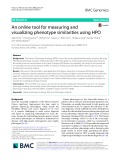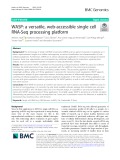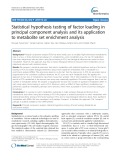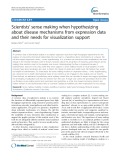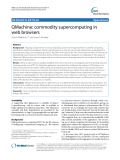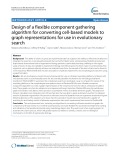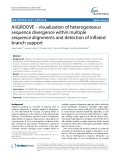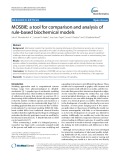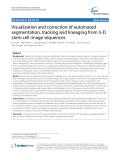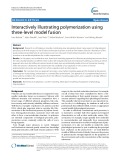
Bioinformatics visualization
-
Several bioinformatic tools have been developed for genome-wide identification of orthologous and paralogous genes. However, no corresponding tool allows the detection of exon homology relationships. Here, we present ExOrthist, a fully reproducible Nextflow-based software enabling inference of exon homologs and orthogroups, visualization of evolution of exon-intron structures, and assessment of conservation of alternative splicing patterns.
 23p
23p  viarchimedes
viarchimedes
 26-01-2022
26-01-2022
 5
5
 0
0
 Download
Download
-
The workflow or framework includes the following steps: data processing, sequence clustering, taxonomic assignment, and data visualization. Moreover, we also like to catch readers’ attention to the information about bacterial communities living in the ocean as most marine microorganisms are unculturable, especially residing in coral reefs, namely, bacteria are associated with the coral Acropora tenuis in this case.
 11p
11p  spiritedaway36
spiritedaway36
 25-11-2021
25-11-2021
 8
8
 1
1
 Download
Download
-
The Human Phenotype Ontology (HPO) is one of the most popular bioinformatics resources. Recently, HPO-based phenotype semantic similarity has been effectively applied to model patient phenotype data. However, the existing tools are revised based on the Gene Ontology (GO)-based term similarity. The design of the models are not optimized for the unique features of HPO. In addition, existing tools only allow HPO terms as input and only provide pure text-based outputs.
 9p
9p  vitzuyu2711
vitzuyu2711
 29-09-2021
29-09-2021
 19
19
 1
1
 Download
Download
-
Long-read sequencing has great promise in enabling portable, rapid molecular-assisted cancer diagnoses. A key challenge in democratizing long-read sequencing technology in the biomedical and clinical community is the lack of graphical bioinformatics software tools which can efficiently process the raw nanopore reads, support graphical output and interactive visualizations for interpretations of results.
 8p
8p  vitzuyu2711
vitzuyu2711
 29-09-2021
29-09-2021
 12
12
 1
1
 Download
Download
-
The technology of single cell RNA sequencing (scRNA-seq) has gained massively in popularity as it allows unprecedented insights into cellular heterogeneity as well as identification and characterization of (sub- )cellular populations.
 11p
11p  vilichoo2711
vilichoo2711
 23-06-2021
23-06-2021
 13
13
 2
2
 Download
Download
-
Pedigree files are ubiquitously used within bioinformatics and genetics studies to convey critical information about relatedness, sex and affected status of study samples. While the text based format of ped files is efficient for computational methods, it is not immediately intuitive to a bioinformatician or geneticist trying to understand family structures, many of which encode the affected status of individuals across multiple generations.
 5p
5p  viwyoming2711
viwyoming2711
 16-12-2020
16-12-2020
 11
11
 1
1
 Download
Download
-
Principal component analysis (PCA) has been widely used to visualize high-dimensional metabolomic data in a two- or three-dimensional subspace. In metabolomics, some metabolites (e.g., the top 10 metabolites) have been subjectively selected when using factor loading in PCA, and biological inferences are made for these metabolites.
 9p
9p  vikentucky2711
vikentucky2711
 26-11-2020
26-11-2020
 12
12
 0
0
 Download
Download
-
Amino acid sequences and features extracted from such sequences have been used to predict many protein properties, such as subcellular localization or solubility, using classifier algorithms. Although software tools are available for both feature extraction and classifier construction, their application is not straightforward, requiring users to install various packages and to convert data into different formats.
 10p
10p  vikentucky2711
vikentucky2711
 26-11-2020
26-11-2020
 8
8
 0
0
 Download
Download
-
A common class of biomedical analysis is to explore expression data from high throughput experiments for the purpose of uncovering functional relationships that can lead to a hypothesis about mechanisms of a disease. We call this analysis expression driven, −omics hypothesizing.
 12p
12p  vikentucky2711
vikentucky2711
 26-11-2020
26-11-2020
 7
7
 0
0
 Download
Download
-
Interaction between proteins is one of the most important mechanisms in the execution of cellular functions. The study of these interactions has provided insight into the functioning of an organism’s processes.
 8p
8p  vikentucky2711
vikentucky2711
 26-11-2020
26-11-2020
 11
11
 0
0
 Download
Download
-
Ongoing advancements in cloud computing provide novel opportunities in scientific computing, especially for distributed workflows. Modern web browsers can now be used as high-performance workstations for querying, processing, and visualizing genomics’ “Big Data” from sources like The Cancer Genome Atlas (TCGA) and the International Cancer Genome Consortium (ICGC) without local software installation or configuration.
 12p
12p  vikentucky2711
vikentucky2711
 26-11-2020
26-11-2020
 11
11
 0
0
 Download
Download
-
The ability of science to produce experimental data has outpaced the ability to effectively visualize and integrate the data into a conceptual framework that can further higher order understanding. Multidimensional and shape-based observational data of regenerative biology presents a particularly daunting challenge in this regard.
 14p
14p  vikentucky2711
vikentucky2711
 26-11-2020
26-11-2020
 8
8
 1
1
 Download
Download
-
Detection of large genomic rearrangements, such as large indels, duplications or translocations is now commonly achieved by next generation sequencing (NGS) approaches. Recently, several tools have been developed to analyze NGS data but the resulting files are difficult to interpret without an additional visualization step.
 6p
6p  vikentucky2711
vikentucky2711
 26-11-2020
26-11-2020
 7
7
 0
0
 Download
Download
-
The biological world is replete with phenomena that appear to be ideally modeled and analyzed by one archetypal statistical framework - the Graphical Probabilistic Model (GPM). The structure of GPMs is a uniquely good match for biological problems that range from aligning sequences to modeling the genome-to-phenome relationship.
 20p
20p  vikentucky2711
vikentucky2711
 26-11-2020
26-11-2020
 16
16
 1
1
 Download
Download
-
The software available to date for analyzing image sequences from time-lapse microscopy works only for certain bacteria and under limited conditions. These programs, mostly MATLAB-based, fail for microbes with irregular shape, indistinct cell division sites, or that grow in closely packed microcolonies.
 10p
10p  vikentucky2711
vikentucky2711
 26-11-2020
26-11-2020
 11
11
 1
1
 Download
Download
-
Plant breeders use an increasingly diverse range of data types to identify lines with desirable characteristics suitable to be taken forward in plant breeding programmes. There are a number of key morphological and physiological traits, such as disease resistance and yield that need to be maintained and improved upon if a commercial variety is to be successful.
 15p
15p  vikentucky2711
vikentucky2711
 26-11-2020
26-11-2020
 9
9
 1
1
 Download
Download
-
Masking of multiple sequence alignment blocks has become a powerful method to enhance the tree-likeness of the underlying data. However, existing masking approaches are insensitive to heterogeneous sequence divergence which can mislead tree reconstructions.
 15p
15p  vikentucky2711
vikentucky2711
 26-11-2020
26-11-2020
 10
10
 1
1
 Download
Download
-
Mechanistic models that describe the dynamical behaviors of biochemical systems are common in computational systems biology, especially in the realm of cellular signaling. The development of families of such models, either by a single research group or by different groups working within the same area, presents significant challenges that range from identifying structural similarities and differences between models to understanding how these differences affect system dynamics.
 16p
16p  vikentucky2711
vikentucky2711
 26-11-2020
26-11-2020
 12
12
 2
2
 Download
Download
-
Neural stem cells are motile and proliferative cells that undergo mitosis, dividing to produce daughter cells and ultimately generating differentiated neurons and glia. Understanding the mechanisms controlling neural stem cell proliferation and differentiation will play a key role in the emerging fields of regenerative medicine and cancer therapeutics. Stem cell studies in vitro from 2-D image data are well established.
 14p
14p  vikentucky2711
vikentucky2711
 26-11-2020
26-11-2020
 9
9
 1
1
 Download
Download
-
Research in cell biology is steadily contributing new knowledge about many aspects of physiological processes, both with respect to the involved molecular structures as well as their related function. Illustrations of the spatio-temporal development of such processes are not only used in biomedical education, but also can serve scientists as an additional platform for in-silico experiments.
 16p
16p  vikentucky2711
vikentucky2711
 26-11-2020
26-11-2020
 11
11
 2
2
 Download
Download
CHỦ ĐỀ BẠN MUỐN TÌM










